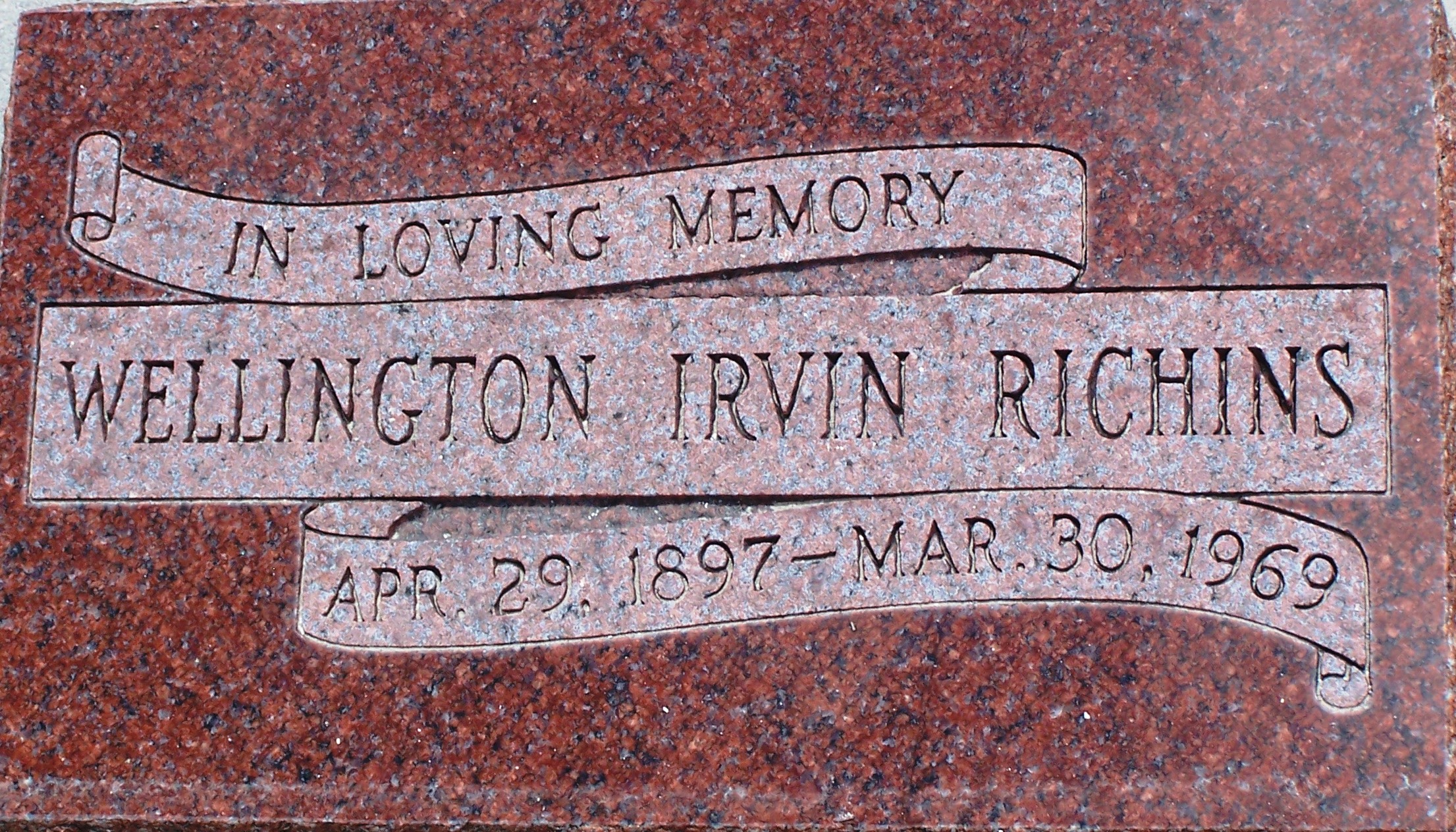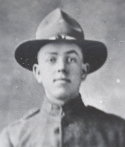 Wellington Irvin Richins, son of Albert Francis and Mary Jane Jones was born on April 29, 1897 at Grouse Creek, Box Elder County, Utah in the log house across the lane from the rock house. This property was my father’s homestead.
Wellington Irvin Richins, son of Albert Francis and Mary Jane Jones was born on April 29, 1897 at Grouse Creek, Box Elder County, Utah in the log house across the lane from the rock house. This property was my father’s homestead.
I spent my early school days partly in a log school east of the present church and in the sand rock school building and graduated from there at the age of fourteen after having completed the eighth grade. The next two years I attended Weber Academy in Ogden, Utah and took up carpentry and cabinet making. I lived with my oldest sister, Eliza Blackburn, while I was at school in Ogden.

Ernest Kimber & Wellie Richins
I was blessed by my uncle, Philip A. Paskett on July 4, 1897. I was baptized on August 12, 1905 by Charles Lucas and confirmed by Charles C. Toyn.
While a Deacon in the Grouse Creek ward I served as President of that quorum until I was ordained a Teacher.
While a very young man I used to go with my brothers up to the summer camp known as the field in Joe Darrah Creek to herd horses. While at this work I learned to love and admire horses. Since that time I have owned some very fine horses.
I was called into the United States Army on August 26, 1918, was sent to Camp Lewis, Washington, where I was stationed until the end of the first World War. I was stricken with influenza and was in the hospital for some six weeks. While I was sick, the orders came for our troops to sail to Europe. I was left behind and released from the hospital three days after they sailed. On returning to my company I was made a Corporal and assigned to be company clerk. This office I held at the time of my release on January 23, 1919. I arrived back home on January 27, 1919.
On May 19, 1920, I was married to Ruby Douglas, daughter of James Douglas and Mary Elizabeth (Jackson) Toyn, in the Salt Lake Temple.
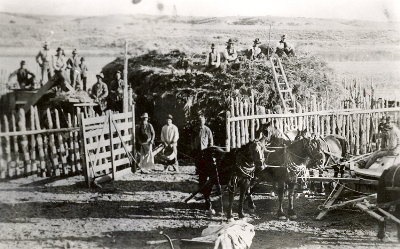
Thrashing Machine: George Paskett, Willington Richins, Newell Richins, Moroni Tanner, Uknown, Uknown, Orson Richins – Haystack: Unknown, Ralph Tanner, Valison Tanner Jr., Uknown, Sidney Paskett – Ground: Lorenzo Richins, Wilford Richins, Albert F. Richins and Phillip Paskett
I worked on my father’s ranch most of the time when I was not living on my homestead. My homestead is in the same area where I herded horses when I was a boy. Others of my family who had homesteaded close by were Newell, Orson, Ether, Almie, and Wiff and my mother. The “lower” field was my mothers and it became by inheritance.
We proved up on the homestead, starting in 1925. I built a one room log cabin, a corral, and dug out a spring for drinking water. I piped the water downhill to the corral. Ruby and I would take our three oldest children with the team and wagon and go to the cabin where we would stay for two or three weeks. We fenced the land with the help of Lawrence Kimber and Bill and Martin Mecham. We were truly pioneers. Food and other supplies were very short. Ruby would gather service berries for breakfast. We had water gravy on broken bread mostly for dinner and occasionally a rabbit, when I was able to shoot one. For supper we had bread and milk. Our cow and three old “biddy” sheep were kept in the corral near the house to keep them from coyotes and mountain lions. Our transportation was by horses and wagon. We tried to get to church as often as we could, but it was a dusty and rough ride for the family.
LaRene was born on March 30, 1921 in what is known as Uncle Lo’s house (Lorenzo Richins home just south of the cemetery) which we were renting at the time. In October we moved to Ogden City for a few months and I worked for Ogden City water works and obtained enough money to buy our winter clothes and groceries.

Work Crew 1-Joe Bardsley, 2-W.I. Richins, 3-Miles Bardsley, 4-Gilbert Monsen, 5-Don Wakefield, 6-W.C Betteridge, 7-Winfred Kimber, 8-Elmer Kimber, 9-C.C. Richins, 10-Arlin Wakefield, 11-Fred Jorgensen, 12-M.E. Wakefield, 13-E.O. Kimber
On returning home to Grouse Creek we lived in the James Betteridge house just west of the church house. (It was now my brother, Wiff’s, house.) While living there Virginia was born on March 4, 1923.
It was this year (1923) that I started shearing sheep and have sheared each spring since with the exception of six or seven years. My brother Wiff taught me to shear when I was about seventeen years of age.
In the summer of 1924 we moved into the old log house across the lane where I was born.
On January 20, 1925 Douglas was born in the same room in the log house where I had been born. It was a very cold winter and lots of snow.
I worked the summer for George (the Kid) Blanthorn and Sam Simpson. In the fall I started work for Midas Wakefield and remodeled the Post Office and store, after which I built a large log warehouse to the north side. I hauled iron pipe for the Southern Pacific Railroad at Lucin, Utah, which lasted until April 1, 1927. Part of that summer I again worked for George Blanthorn and Sam Simpson. Through the winter I fed cattle on my father’s place.
In the fall of 1928 we rented C. William Kimber’s farm. I sold a lot of my horses and bought a car, a 1927 model Chevrolet.
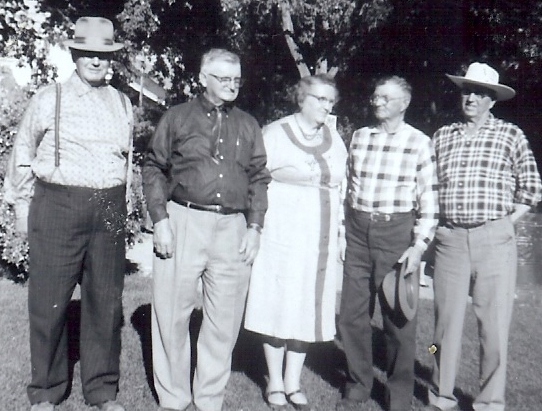
Joseph Ether Richins, Orson Richins, Nola Richins Kimber, Wilford Richins, Wellington Richins – 1960
In December I took Ruby, with Virginia and Douglas, to Lucin where they caught the train to Ogden. They stayed with my sister Eliza there until after Virgil was born on December 26, 1928. I met them on January 29, 1929 at Lucin with a covered sleigh and a four horse team. I filled the sleigh with blankets and set up a coal stove in it to keep us warm on the return trip home. While her mother was gone LaRene stayed with Jennie and Newell.
Snow was three feet deep on the level that winter. This helped to insure us a good crop on the place we had rented.
In the spring of 1929 I bought heifers from McKellar out at Wendover to stock the ranch I’d leased. Then came the great depression and a drought. In 1931 the United States government saw the need for ranchers to get rid of their cattle so they bought them at a very low price of $11.00 per cow and $4.00 per calf. They took the cows away and killed the calves in the yard. This deal depleted my herd to some four or five head.
In the fall of 1931, because the drought had been so bad, most of the Richins cattle and the Douglas cattle were trailed to Burley, Idaho to be fed. My brother, Newell, his wife, Jennie, and my father-in-law and mother-in-law went with the cattle. Several men were employed to help with the herd for the winter, among them were August Rytting, William Frost, and my brother Orson. I stayed with my father’s ranch in Grouse Creek and took care of the remaining stock.
Father became ill on January 17, 1932. He died at my sister Eliza’s house on April 26, 1932 and was buried at Grouse Creek.
That fall my family moved from my sister’s house near the store down the street to the rock house (my parent’s house) so we could be on hand to take care of my mother’s needs. We tore down the old store room on the north east corner and rebuilt a nice room there with railroad ties. The ties were some I had hauled from Lucin.
In 1933 Ruby and I were up Dry Canyon getting some wood for winter when I had the misfortune of cutting my foot with the ax. We went home with what wood we had. Lawrence Kimber drove my car and took me to Montello, Nevada, where there was a railroad doctor, who dressed my wound and stitched the cut made by the ax. The tendons of two of my toes had been severed. I used crutches for about six weeks.
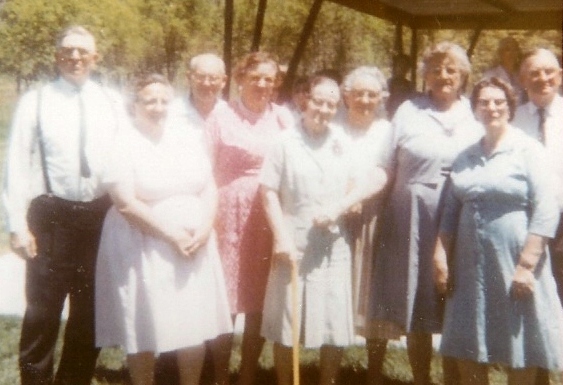
Wellie, Sophie, Lawrence, Nola, Mabel, Dora, Orita, Wilford & Hattie Richins-1967
A road, under the governments work project, was being built between Grouse Creek and Etna. George Ballingham and I drove four horses on each grade to make the road, after which we put our teams on dump wagons and hauled gravel onto the same road until the spring of 1934.
The summer of 1934 I went with Elmer Kimber over to the HD ranch in Nevada with my team and raked hay for thirty-three days without a day off. For several years in the fall, I and the other fellows would go to Burley, Idaho and pick potatoes for a few weeks. We would usually stay long enough to earn enough money to buy our winter supply of potatoes and flour and other groceries for winter.
I went with George Paskett to the San Jacinto ranch in Nevada to put up hay. I was gone thirty-five days and then returned to make the spud picking in Burley again. At Burley, Idaho I helped in the sugar beet fields.
I was President of the Elders’ quorum of the Grouse Creek ward, President of the Young Men’s Mutual Improvement Association, and Secretary of that organization for about six years.
In my grade school years I took piano lessons from a school teacher whose name was A.N. Porter. This gave me a good introduction to music and the piano, then while attending school at Ogden in 1912 and 1913 and 1914 I took lessons again from a lady, whose name was Mrs. Ralph Hunter. I paid for most of the lessons by doing work for her around the place and caring for her chickens and keeping her yards clean and tidy.
In the fall of 1936 I moved my family to Tremonton, Utah, so my older children could attend high school and I returned to Montello, Nevada to do carpentry work. We put another story on a one story school building. After returning to Tremonton I was out of work all winter until David Holmgren gave me a job for a few days remodeling the house on his farm east of Tremonton. He continued giving me work until I finally got a good start at doing carpenters’ work.
In the spring of 1938 I remodeled the Safeway store and made the Oak Café, which had been Safeways store room. Around April 20, 1938, I came back to Grouse Creek and sheared sheep at the Kimber ranch.
For some fifteen years I went with a crew of men to shear sheep at the Utah Construction Company ranches in Nevada.
I moved back to Tremonton in the fall of 1938 for my children’s schooling and I built a large barn on David Holmgren’s farm east of Tremonton. The barn’s most unique feature is the curved roof of the Gothic arch. The wood for the trusses was soaked in the farm’s pond until pliable. Then the wood was placed in forms on the ground to dry in the curved shape needed to form the open arch of the barn.
About the unique design of the roof, Richins wrote in his journal, ” The rafter beams were clamped and put in the pond on the farm for shaping. My friend Les Barnes helped me move the clamps every few days. We would wade into the pond and force the beams to curve and reclamp them until the shape was right. The water was very cold. I worked on the barn until the spring of 1939 and finished it the next fall. Mr. Holmgren had my initials carved into the cement by the barn along with his own. He said he wanted his grandchildren and my grandchildren and their posterity to know who built that barn.”
In 1940, when Richins remodeled the Holmgren home he worked 110 hours at .55 cents an hour. He was paid a total of $60.50.
This barn is still standing and is listed with the Utah Historical Society of Utah.
That same fall, the Safeway store caught fire. I got the job of repairing it, which gave me work most of the winter. In 1940 I built a home for Martin Hansen and in the summer put up hay on Dave Holmgren’s farm in Bear River City.
In February 1940, LaRene married George Napoli, who was operating the Oak Café. They have six nice children, five girls and one boy.
We were in Grouse Creek all the summer of 1941. In the fall, Virgil became sick and we were quite concerned about him. We decided to take him to the doctor at Burley. We left in the very early hours of the morning. It took us quite a while as every little jar of the car would be very painful to him. Virgil had ruptured appendix.
While Virgil was on the operating table, Ruby and I went to our car and offered a prayer in his behalf, that the doctor would use his skill to his utmost efficiency and as a result we have him today and he has a fine wife and family. (This was the first time sulfanilamide had been used in the Burley hospital. It was in powder form and the doctor used handfuls inside and out of Virg’s body.)
I worked for my brother Alma in the potato fields while Virgil was in the hospital for a month and when he recovered we returned to Grouse Creek and then to Tremonton.
In the late spring of 1942 Douglas also had his appendix removed.
World War II with Japan was on and the government was building hospitals and supply depots in northern Utah. Most of the carpenters left to get steady work on the projects so I stayed around and was kept so busy that I had to do some work at night. During this time I built a house for Leland (Joe) Anderson in Bothwell and remodeled houses all over the Bear River Valley, but mostly in Thatcher and Bothwell.
I was an Assistant Scout Master in Tremonton 1st Ward. I also belonged to the ward choir for years. I had been a member of the Grouse Creek Wards’ choir ever since I was a young man. I love music and I enjoy singing the songs of Zion.
In 1942 I built a house on the Willis Nelson farm in Pocatello Valley and took half my pay in cash and a registered bull for the balance. I did some work for Gene Leavitt at Fielding and took a saddle horse for that work.
In about 1943, I bought a tractor and plow and harrows and began breaking and clearing the brush off the land I had in Dry Canyon. (This land had been my sister Eliza’s homestead, but following her death it became tax delinquent. I bought it from the county.) The first two or three years I didn’t get a very good crop of dry land grain, but finally for about five years I got good crops. Each year I broke up more until there is about 100 acres broken up.
In the fall of 1944 Ruby had a bad sick spell and was confined to the hospital in Ogden with a very weak heart.
During this time I was leasing the John Hadfield place in Grouse Creek from his son, Edwin S. Hadfield. I finally bought it from him for $1550. At the same time I bought two and one-fourth sections of range land from Southern Pacific Land Co. on a ten-year contract. This was 1440 acres in the Red Butte area.
We did very well with our crops and cattle, but Ruby’s health condition was getting continually more serious, which necessitated us spending quite a lot of time near a doctor.
Virginia went to northeast Maryland and married Clifford C. Ulary on May 18, 1946.
While I was working at the Willis Nelson place in Pocatello Valley the LDS church architect asked me to take the job of remodeling the Grouse Creek church. I remodeled both floor levels and installed an oil furnace.
In the spring of 1944, when we went back to Grouse Creek from Tremonton, where we had spent the winter to put Virgil in school, we found that my brother Newell had moved into the rock house and we had to resort to living at the “greenhouse,” which was the Douglas home.
The place had not been taken care of. We cleared the lot of sage brush and weeds. Windows had been broken, which allowed mice and birds to enter. We cleaned and painted and remodeled the inside. When Grouse Creek put in the new pipe line, we bought a share of water and piped the water into the house. When electric power came in about 1954, we installed electricity. We had been told to make the place “home” when we moved in, but after the electricity had been put in, members of the family told us the place was not going to be ours. This was quite a blow after all we had done to the place. We acquired this place in 1956 by payment of delinquent taxes.
My sons, Douglas and Virgil, were both married in 1948. Doug married Luana Tingey on July 20th and Virg married Sharon Hales on August 12th. The girls were from Riverside, Utah and they were second cousins. Three boys and one girl were born to each of these unions.
Virginia and Cliff had come west in 1947 and lived in Ogden. Their daughter, Bonnie, was born and they moved back east again against Virginia’s wishes. Trouble developed and Virginia and Bonnie came back to Tremonton in July 1952. We all lived with LaRene that winter so Virginia could get work and Ruby could be close to a doctor.
After some time Virginia obtained a divorce. She married Boyd J. Empey in the Idaho Falls Temple on July 6, 1955.
I built a display room for Dunkley Music Company of Ogden in the Orpheum Theater building and a home for Willis Dunkley on the bench in the south and east of Ogden City. When we settled up that fall, I took $150.00 and a new piano.
In the first part of September, Ruby became very ill and was placed in the Dee Hospital in Ogden. God called her “home” on September 20, 1956. She was laid to rest in the Grouse Creek cemetery on September 24, 1956.
The next day when things began to clear and as time went on I looked around for my family and my friends. Where were they? Where were my Bishopric and my ward teachers? None of them came and I sat alone night after night, hanging onto the one thing I have left, the Priesthood, which God had given me and hoping that some way things would straighten out. I spent days, fasting and praying and asking God to help me to do that which was right.
I stayed in Grouse Creek working on my place and gathering cattle.
I corresponded with Sophie Woerner. When I went to Tremonton for Christmas we became engaged. On January 5, 1957 I baptized her into the Church of Jesus Christ of Latter-day Saints. Sophie was very happy to become a member of the church. We were married in the courthouse at Ogden, Utah, on January 23, 1957.
On October 27, 1957, we had a dear little boy born to us. Sophie and I were married in the Logan Temple on February 21, 1958 and had Lynn sealed to us. Those who went through the temple with us were my son, Douglas and his wife, Luana, my sister, Nola Kimber and my cousin’s daughter, Emma Barlow Kimber.
In 1958 I built two outdoor fire circles and restrooms and utility building at the south park in Tremonton.
On August 10, 1958 I was admitted to the Valley Hospital in Tremonton with encephalitis (sleeping sickness). An epidemic of this disease hit Utah and southern Idaho about the first of July. Some died suddenly, others recovered satisfactorily and some became life cripples. I felt my life slipping away on the third day, but through the power of the priesthood I was healed. Since then, I have had terrible headaches and I have lost vision in the lower half of my right eye as a result of the disease.
In March 1960 we went to New York to be present at the wedding of Sophie’s son, Bruce. I thought I would never in my life get to see New York, Chicago, Buffalo, Albany and other points of interest along the trail my mother had taken when she came to Utah from England.
In the spring of 1959 I obtained a bulldozer from the Bureau of Land Management and got Doug to run it and we made a large dam in Dry Canyon. So far it hasn’t proved much success. We dug one of those at the homestead deep enough to obtain ground water. In 1960 we blasted it and cribbed it up with railroad ties. It works pretty well.
In 1959 I built a summer home on the Bear Lake at Garden City, Rich County, Utah for Ray Ashcraft.
In 1959, Newell, my brother, had cancer of the prostate. He passed away on April 30, 1960 in the Dee Hospital in Ogden.
Another blow that came to my life was when the old homestead of my parents was lost to bankruptcy. On December 18, 1959 I bought from Newell’s bankruptcy sale 200 acres of range land for $1,260.00. This property is next to my homestead.
In the fall of 1960 I built a large building for the Bureau of Land Management at Grouse Creek.
In the spring of 1961 I rented a farm in Deweyville. We managed to raise enough hay there to feed the cattle through the following winter.
My brother, Orson, passed away in 1961.
Sophie and I bought a new home in Melody Park at Tremonton in the fall of 1961. On May 12, 1961 Sophie and I were blessed with a lovely and sweet daughter. We named her Mary Jane after my mother.
Great sadness came to our family when we lost Virgil’s oldest son, Wade, with acute leukemia. He died on December 27, 1962.
We left our house in Melody Park area and moved back into the first ward. Within six months I had born to me my son Gerald, my grandsons Stephen and Brent, and my great granddaughter, Christy.
Our little son, Gerald Allan was born on November 14, 1964.
Douglas and Virgil were needed by their families so they spent less and less time at Grouse Creek. I relied on my oldest grandson, Robert Napoli, to help with the cows and to help repair fences. We would truck the cattle to the hills in the summer and return them by truck to the feed yard at Lester Barnes place in Tremonton when late fall weather got bad.
I continued to do carpenter jobs here and there. Each spring I would go shearing with Lester Barnes.
This winter of 1968-69 I have been in and out of the hospital several times with cancer.
My brother, Will and his wife, Hattie was killed in a car wreck in February 1969. Our family is getting smaller. My sister, Nola, and I remain.
Wellie died on March 30, 1969 and was interred in Grouse Creek Cemetery.
